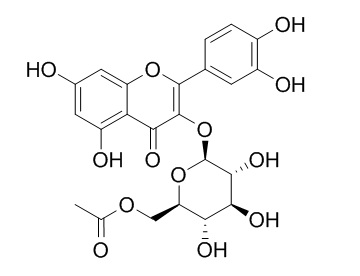Quercetin-3-O-glucose-6''-acetate
Quercetin-3-O-glucose-6''-acetate is a NADPH oxidase inhibitor, it has antioxidant capacity.
Inquire / Order:
manager@chemfaces.com
Technical Inquiries:
service@chemfaces.com
Tel:
+86-27-84237783
Fax:
+86-27-84254680
Address:
1 Building, No. 83, CheCheng Rd., Wuhan Economic and Technological Development Zone, Wuhan, Hubei 430056, PRC
Providing storage is as stated on the product vial and the vial is kept tightly sealed, the product can be stored for up to
24 months(2-8C).
Wherever possible, you should prepare and use solutions on the same day. However, if you need to make up stock solutions in advance, we recommend that you store the solution as aliquots in tightly sealed vials at -20C. Generally, these will be useable for up to two weeks. Before use, and prior to opening the vial we recommend that you allow your product to equilibrate to room temperature for at least 1 hour.
Need more advice on solubility, usage and handling? Please email to: service@chemfaces.com
The packaging of the product may have turned upside down during transportation, resulting in the natural compounds adhering to the neck or cap of the vial. take the vial out of its packaging and gently shake to let the compounds fall to the bottom of the vial. for liquid products, centrifuge at 200-500 RPM to gather the liquid at the bottom of the vial. try to avoid loss or contamination during handling.
Horticulturae2022, 8(10), 975.
Biochem Biophys Res Commun.2020, 522(1):40-46
Food Chem Toxicol.2020, 135:110863
Heliyon.2023, 9(6):e16138.
Pharmaceutics.2022, 14(5):945.
Journal of Food Composition and Analysis2021, 100:103905.
Processes 2021, 9(5),894.
Plant Cell, Tissue and Organ Culture (PCTOC)2020, 143, 45-60(2020)
J Ethnopharmacol.2023, 317:116789.
LWT2024, v208:116677
Related and Featured Products
J Food Sci. 2011 Aug;76(6):C869-73.
Flavonol content in the water extract of the mulberry (Morus alba L.) leaf and their antioxidant capacities.[Pubmed:
22417484]
The biological activities of the mulberry (Morus alba L.) leaf have been attributed to its flavonoid content.
METHODS AND RESULTS:
The water extract of the mulberry leaf (WEML) was prepared by autoclaving at 121 °C for 15 min, and the flavonol content of the WEML was determined by HPLC The WEML contained 4 flavonols in the following order: quercetin-3-β-D-glucose (QT-G) > quercetin-3-O-glucose-6″-acetate (QT-GA) > rutin (RT) > quercetin (QT). In the oxygen radical absorbance capacity (ORAC) assay, QT had the highest peroxyl radical-scavenging capacity and a similar hydroxyl radical-scavenging capacity as its glycosides (QT-G, QT-GA, and RT).
CONCLUSIONS:
QT exhibited a stronger cellular antioxidant capacity (CAC) against 2,2'-Azobis(2-amidinopropane) dihydrochloride (AAPH)- and Cu²⁺-induced oxidative stress in HepG2 cells compared to its glycosides, indicating that the intracellular antioxidant capacity of QT and its glycosides may depend upon both the permeability across the cell membrane and the peroxyl or hydroxyl radical-scavenging capacity.
Mol Cell Biochem. 2011 Jun;352(1-2):91-8.
A Drosophila model for the screening of bioavailable NADPH oxidase inhibitors and antioxidants.[Pubmed:
21312054]
NADPH oxidase is the major source of non-mitochondrial cellular reactive oxygen species (ROS), and also is reported to be a major cause of various diseases including atherosclerosis and hypertension.
METHODS AND RESULTS:
In order to screen a new curative reagent that can suppress NADPH oxidase activity, we developed a Drosophila melanogaster fly that would overexpress human Dual oxidase 2 (hDuox2), a member of the NADPH oxidase family, as a screening model. These flies (GMR-GAL4/UAS-hDuox2) had a high generation of ROS in the posterior region of the eye discs along with an easily recognizable rough-eye phenotype, which is an ideal and convenient marker for further screening steps. Moreover, the hDuox2-induced rough-eye phenotype can be rescued by feeding with a culture medium containing mulberry leaves (MLs), which reportedly have an antimetabolic effect. Some commercially available antioxidants such as quercetin-3-O-D-glucoside or Quercetin-3-O-glucose-6''-acetate, or the naringin contained in MLs and other herbs, also have shown a similar suppressing effect on the rough-eye phenotype.
METHODS AND RESULTS:
Our results suggest that flavonoid glycoside is absorbed from the intestine and functions in the body of D. melanogaster as it does in mammalian models such as rats. Thus, the GMR-GAL4/UAS-hDuox2 fly line is a promising model for the screening of novel drugs such as NADPH oxidase inhibitors and/or antioxidants.



